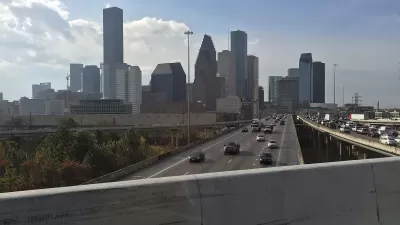With the project still under federal investigation, local and state agencies say they are moving forward with the development of design details for the contentious freeway redesign.

The controversial plan to rebuild and widen parts of Interstate 45 in Houston is once again moving forward after the city and the Texas Department of Transportation (TxDOT) came to an agreement at the end of last year.
As reported by Dug Begley for the Houston Chronicle, details of the agreement, which will require plans for rebuilding Interstate 69 under a light rail line, flood control projects, sidewalks and bikeways, and details for how changes to I-45 will impact connecting roads, remain to be worked out.
Meanwhile, a Federal Highway Administration (FHWA) review of the project and potential civil rights violations is still in progress. As Begley explains, “Though minor changes have reduced some of the effects, TxDOT’s approved project impacts — the catchword for any structure or dwelling directly touched by the changing road boundary — include 158 houses, 433 apartments or condos, 486 public housing units, 340 businesses, five churches and two schools.”
The North Houston Highway Improvement Project has been at the heart of a fierce debate over the future of downtown Houston, with critics calling for a new approach to transportation and mobility that rejects the perpetuation of unsustainable, car-oriented planning. “In a statement, Air Alliance Houston said the agreements ‘will do very little to protect Houston communities from the harms posed by this project,’ specifically related to air pollution caused by the larger freeway in many neighborhoods around the central business district.”
FULL STORY: TxDOT has deal to rebuild I-45, but many details must be worked out before lifting a shovel

Trump Administration Could Effectively End Housing Voucher Program
Federal officials are eyeing major cuts to the Section 8 program that helps millions of low-income households pay rent.

Planetizen Federal Action Tracker
A weekly monitor of how Trump’s orders and actions are impacting planners and planning in America.

Ken Jennings Launches Transit Web Series
The Jeopardy champ wants you to ride public transit.

Opinion: Transit Agencies Must View Service Cuts as Last Resort
Reducing service could cripple transit systems by pushing more riders to consider car ownership, making future recovery even less certain.

‘Smart Surfaces’ Policy Guide Offers Advice for Building and Maintaining Urban Tree Canopies
Healthy, robust tree canopies can reduce the impacts of extreme heat and improve air quality.

New Jersey Lawsuit Targets Rent-Setting Algorithms
The state of New Jersey is taking legal action against landlords and companies that engage in what the state’s Attorney General alleges is illegal rent fixing.
Urban Design for Planners 1: Software Tools
This six-course series explores essential urban design concepts using open source software and equips planners with the tools they need to participate fully in the urban design process.
Planning for Universal Design
Learn the tools for implementing Universal Design in planning regulations.
Heyer Gruel & Associates PA
Ada County Highway District
Institute for Housing and Urban Development Studies (IHS)
City of Grandview
Harvard GSD Executive Education
Toledo-Lucas County Plan Commissions
Salt Lake City
NYU Wagner Graduate School of Public Service





























